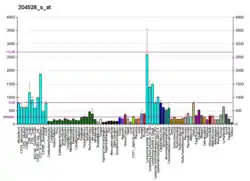NAP1L1
Nucleosome assembly protein 1-like 1 is a protein that in humans is encoded by the NAP1L1 gene.[5][6]
This gene encodes a member of the nucleosome assembly protein (NAP) family. This protein participates in DNA replication and may play a role in modulating chromatin formation and contribute to the regulation of cell proliferation. Alternative splicing of this gene results in several transcript variants; however, not all have been fully described.[6]
References
- GRCh38: Ensembl release 89: ENSG00000187109 - Ensembl, May 2017
- GRCm38: Ensembl release 89: ENSMUSG00000058799 - Ensembl, May 2017
- "Human PubMed Reference:". National Center for Biotechnology Information, U.S. National Library of Medicine.
- "Mouse PubMed Reference:". National Center for Biotechnology Information, U.S. National Library of Medicine.
- Simon HU, Mills GB, Kozlowski M, Hogg D, Branch D, Ishimi Y, Siminovitch KA (Mar 1994). "Molecular characterization of hNRP, a cDNA encoding a human nucleosome-assembly-protein-I-related gene product involved in the induction of cell proliferation". Biochem J. 297 (2): 389–97. doi:10.1042/bj2970389. PMC 1137842. PMID 8297347.
- "Entrez Gene: NAP1L1 nucleosome assembly protein 1-like 1".
Further reading
- Kato S, Sekine S, Oh SW, et al. (1995). "Construction of a human full-length cDNA bank". Gene. 150 (2): 243–50. doi:10.1016/0378-1119(94)90433-2. PMID 7821789.
- Asahara H, Tartare-Deckert S, Nakagawa T, et al. (2002). "Dual roles of p300 in chromatin assembly and transcriptional activation in cooperation with nucleosome assembly protein 1 in vitro". Mol. Cell. Biol. 22 (9): 2974–83. doi:10.1128/MCB.22.9.2974-2983.2002. PMC 133748. PMID 11940655.
- Strausberg RL, Feingold EA, Grouse LH, et al. (2003). "Generation and initial analysis of more than 15,000 full-length human and mouse cDNA sequences". Proc. Natl. Acad. Sci. U.S.A. 99 (26): 16899–903. Bibcode:2002PNAS...9916899M. doi:10.1073/pnas.242603899. PMC 139241. PMID 12477932.
- Ota T, Suzuki Y, Nishikawa T, et al. (2004). "Complete sequencing and characterization of 21,243 full-length human cDNAs". Nat. Genet. 36 (1): 40–5. doi:10.1038/ng1285. PMID 14702039.
- Bouwmeester T, Bauch A, Ruffner H, et al. (2004). "A physical and functional map of the human TNF-alpha/NF-kappa B signal transduction pathway". Nat. Cell Biol. 6 (2): 97–105. doi:10.1038/ncb1086. PMID 14743216. S2CID 11683986.
- Rehtanz M, Schmidt HM, Warthorst U, Steger G (2004). "Direct interaction between nucleosome assembly protein 1 and the papillomavirus E2 proteins involved in activation of transcription". Mol. Cell. Biol. 24 (5): 2153–68. doi:10.1128/MCB.24.5.2153-2168.2004. PMC 350572. PMID 14966293.
- Kho Y, Kim SC, Jiang C, et al. (2004). "A tagging-via-substrate technology for detection and proteomics of farnesylated proteins". Proc. Natl. Acad. Sci. U.S.A. 101 (34): 12479–84. Bibcode:2004PNAS..10112479K. doi:10.1073/pnas.0403413101. PMC 515085. PMID 15308774.
- Ballif BA, Villén J, Beausoleil SA, et al. (2005). "Phosphoproteomic analysis of the developing mouse brain". Mol. Cell. Proteomics. 3 (11): 1093–101. doi:10.1074/mcp.M400085-MCP200. PMID 15345747.
- Gerhard DS, Wagner L, Feingold EA, et al. (2004). "The status, quality, and expansion of the NIH full-length cDNA project: the Mammalian Gene Collection (MGC)". Genome Res. 14 (10B): 2121–7. doi:10.1101/gr.2596504. PMC 528928. PMID 15489334.
- Okuwaki M, Kato K, Shimahara H, et al. (2005). "Assembly and disassembly of nucleosome core particles containing histone variants by human nucleosome assembly protein I." Mol. Cell. Biol. 25 (23): 10639–51. doi:10.1128/MCB.25.23.10639-10651.2005. PMC 1291234. PMID 16287874.
- Nousiainen M, Silljé HH, Sauer G, et al. (2006). "Phosphoproteome analysis of the human mitotic spindle". Proc. Natl. Acad. Sci. U.S.A. 103 (14): 5391–6. Bibcode:2006PNAS..103.5391N. doi:10.1073/pnas.0507066103. PMC 1459365. PMID 16565220.
- Beausoleil SA, Villén J, Gerber SA, et al. (2006). "A probability-based approach for high-throughput protein phosphorylation analysis and site localization". Nat. Biotechnol. 24 (10): 1285–92. doi:10.1038/nbt1240. PMID 16964243. S2CID 14294292.
- Chi A, Valencia JC, Hu ZZ, et al. (2007). "Proteomic and bioinformatic characterization of the biogenesis and function of melanosomes". J. Proteome Res. 5 (11): 3135–44. doi:10.1021/pr060363j. PMID 17081065.
- Olsen JV, Blagoev B, Gnad F, et al. (2006). "Global, in vivo, and site-specific phosphorylation dynamics in signaling networks". Cell. 127 (3): 635–48. doi:10.1016/j.cell.2006.09.026. PMID 17081983. S2CID 7827573.
- Eckey M, Hong W, Papaioannou M, Baniahmad A (2007). "The nucleosome assembly activity of NAP1 is enhanced by Alien". Mol. Cell. Biol. 27 (10): 3557–68. doi:10.1128/MCB.01106-06. PMC 1899999. PMID 17339334.
This article is issued from Wikipedia. The text is licensed under Creative Commons - Attribution - Sharealike. Additional terms may apply for the media files.






